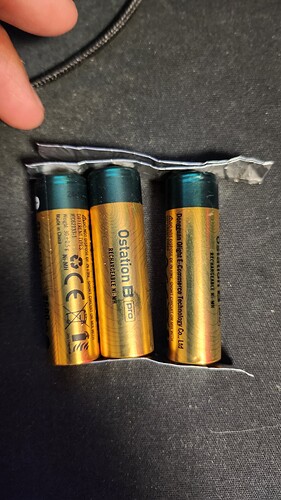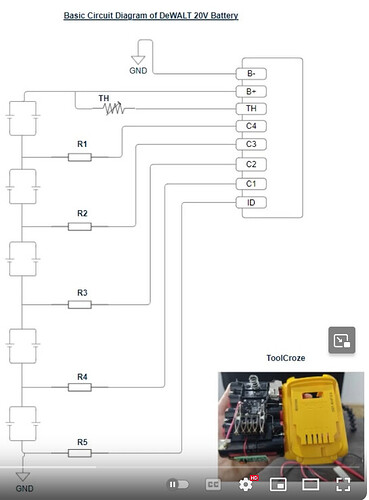I need a way to charge some nimh batteries that are under 1v when measured w/a multimeter. I currently use an old Sanyo NC-mqno5u that came in the Costco pack w/the eneloops back in the day b/c it has a dumb charge mode, whereas my opus btc-3400, liitokala lii-500, zanflare c4 show either ‘null’ on the display or just ignore the battery. Was wondering if the Vapcell in manual mode would do the trick or is it simply to let me choose charging amperage? The sanyo does work for now, but it only handles aa and aaa so for the nimh C batteries like some expensive Ampman LSD batteries i need an option.
I gotchu. Take a bunch of other charged eneloops WITH THE SAME CAPACITY and hook them all up in parallel with the discharged cell. They should balance out.
**TO CLARIFY, make all the positives touch only positives, and make all the negatives touch only negatives.
Like below:
The more discharged a a cell is, the more other eneloops you should add to the parallel circuit. UNDER NO CIRCUMSTANCES SHOULD YOU SHORT THE POSITIVE TO NEGATIVE CONTACTS, THAT’LL BE A SH**TON OF AMPS. THAT MEAN BIG FIRE.
I could see doing this w/one of those trigger type clamps w/the plastic jaws and some aluminum or copper strips, but i was hoping there might be a charger that would do this for me. In my head, i would want one that sends pulses of a specified amperage to batteries for 1-2mins, then stops, measures, then ‘pulses’ again to determine if battery will take the charge, afterward it does a regular charging cycle once voltage is sufficient–using whatever ‘cutoff’ method is best for this kind of charging. for now i do have the sanyo dumb charger, and some other older ‘classic’ ones to use, but the method you use could def work for ‘C’ nimh or even ‘D’.
It’s essentially a “jump”. When stuff is wired in parallel, they usually seek to hit a balance between all the cells involved. You want the cells to be as closely matched in voltage and capacity as possible. Same with car batteries.
Also, i thought the bt3100ct has a refresh function, might want to look up that particular feature
The S4+ is not made for very low voltage cells.
To revive such NiMH I use the Xtar VC4 and ISDT C4 EVO
@Johnny_Bravo ,
Is the ISDT used in ‘activation’ mode for this? Or is it b/c it is just good at detecting low voltage AA/AAA batteries? Also, is it still worth buying if I would just use it for battery recovery, since the long thread you posted on C4 experiences seems to indicate that there are still some bugs/firmware issues–unless things have changed.
Any special setting or reason for the Xtar VC4?
The C4 detected all of the cells I tried so far, no special setting, just inserting cell. The only thing which is confusing it always showed 0,13V
It´s not bug-free, the fan is annoying and it´s not cheap. Not worth it to buy it for NiMH-reviving
The VC4 have no setting (current 0,5A and 1A are “set” by using selected slots) ![]()
It start with a very low charge current for the first 10 or 12 mins, it detected every cell I ever tried (much more than in C4) and I was able to revive most of it. Cells the VC4 won´t charge worked in no other of my chargers (I have a lot)
So it´s my No.1 for such things
The cheapest option would be to make an adaptor for AA to either a C/D holder or magnetic leads, just be careful not to short the charger.
Importantly, why are your cells discharged so far? Are you using them in a device that thinks they’re alkaline? Under a reasonable load, the open circuit of 0.9V will be lower and possibly result in much shortened lifespan for the cells.
from the test of the S4+ (v1) by the Danish reviewer HKJ :
-
At low voltages the meter shows 0.80V [i.e. even if the voltage of the battery is lower]
-
Below 0.4V the charger reports error
so, according to that, it should work from 0.4V on …
but the S4+ cannot charge D-size NiMH batteries … if that is required, the Vapcell BL4 would do that … but I have no info, whether it has exactly the same programming as the S4+ regarding the lowest voltage to allow charging …
both chargers have a “repair” function … for Li-Ion it is advertised to work from “0 Volt” on, but that should only be used for the reset of a protection circuit of the battery, never for the “revive” of an in fact over-discharged Li-Ion !!!
but maybe this mode could be used to revive an NiMH, that cannot be charged in the normal charge program …
the Xtar VC4 works from 0 Volt on, from the test by HKJ :
-
The charger will charge with 100mA from 0 volt and display will show NiMH
-
Charger will not stop NiMH charging within the first 10 minutes.
the VC4 is an older charger, the review is from 2015 …
all that are no recommendations for these chargers, but just a little bit additional info, because they were mentioned here …
0V activation is the reason I bought C4Evo and BL4, while owning Opus bt3100. Either one will do the job. C4Evo will give you more options and flexibility, however they dont update FW often to address issues or to add features. BL4 doesnt have a lot of features and you will never be able to update its FW, however is still reliable and cheaper.
P.S. One thing I realized after finally having 0V functionality is that it’s not the best idea to keep in rotation overly discharged cells. Either because they were originally not great and now degraded, or because they were abused or kept in discharged state for a long period and now degraded. It’s even more dangerous with Li-Ion as I understand. I don’t regret spending some $ on new chargers, but at the end of the day I understand I could have lived without this functionality but I did not want to.
Why does this self-balancing not work with tools batteries 5S2P? There’s often just single cell in one of five 2p that is degraded.
The “S” in your setup is the answer, lol. Anything in series typically will not do the autobalancing.
**in a standard 2p setup, that denotes 2 individual similar cells, wired in parallel with each other, and will balance a charge with the other. Incidentally, this means you get double the capacity with similar cells, i.e. same voltage, same capacity, similar resistance, etc.
In any serialized setup, such as an 18v battery pack, or something 5S2P like yours, will have 2 BATTERIES of 5 cells each. It’s usually one of the cells on one end of either or both of the serial batteries that gets overdrawn/funky, as it sustains the most load out of the other cells in a serial circuit.
Parallel increases capacity while maintaining voltage, serial increases voltage while maintaining capacity, applying a proper combination of the two increases both voltage and capacity, hence likely why it is done in battery packs. 18V @ 5200mAh, I’m guessing.
Yes, I understand S part. I haven’t done it personally but has been researching on how Deawalt, Ryobi and other do / don’t do balancing and how failed packs often contain SINGLE deteriorated cell. It’s often just one. And standard package is 5S2P, so any single cell in the pack has second in parallel. So why this second cell is not trying to balance adjacent degraded cell? Is it because there is also S connected cells, do they somehow preventing P-connected cell from balancing its adjacent cell ?
How’s it wired?
For 18V, i imagine it’s 2 batteries of 5 cell series, so like if 2 tubes of 5 cells are connected at rhe ends. The other, probably more costly way to do it, is to wire 5 pairs of cells together, so 5 series batteries of 2P.
5+5 versus 2+2+2+2+2.
Again, because only one cell degrades, I assume it’s the 5S2P rather than 2P5S…maybe I’ve got my nomenclature all wrong, but that’s the gist of it
**to clarify, if my memory isn’t too rusty,
5S2P means 5 cells in series in a 2 parallel config, so a 5+5,
2p5s means 2 cells wired in parallel, then 5 pairs wired to form a series, or 2+2+2+2+2.
2P5S is usually more cotly because each pack requires an extra set of baseplates or contacts, but is intrinsically safer because the last pair shares the load, rather than the last cell in each 2 of the last 5s bearing the brunt of that series.
Totally missed that 5S2P and 2P5S could mean different connection, thank you reminding it. Battery packs I saw are wired as 2P5S. So I was just curious, just because there are 5 sets of 2P, how come only one cell is often severely degraded and not two of the same 2P block.
In that case, I don’t know, lol…a bad cell from a bad lot, maybe. I have a BLF LT1 lantern, and 2 out of 4 cells, which are all parallel, ended up completely dead. It could be internal resistance of that one cell, it could be that the leads are shorter to one cell than the others, I’ve got no clue…
Because the dead cell is not providing any voltage, a 5 series battery with 1 dead cell is essentially 4 series and a resistor…
Parallel is also bad, if one cell develops a short, not only is it shorting its own capacity, it’s also got 3 other cells dumping energy into the short.
At that point, the shortage of any cell is bad in parallel or series…particularly if the cell starts to reverse its voltage.
***Hopefully there’s fuses or some kind of protection circuit for this.
Thanks for the feedback on those two chargers. the cells in question were some eneloop AAA batteries. I’m not sure which version. The cells were used in my Universal MX-900 remote control, which basically just sits there most of the time.
It looks like the VC4 is around $19 on amazon and the VC4SL is $33. Just to confirm, it’s the VC4 model which would do this? I do still have 4 adapters from my Opus /Ambient Weather BC-2000 for C and D nimh batteries, but I had not thought to try that. I’ll go ahead and order the VC4 vs the $60 C4 EVO. I guess i’ll be getting a Vapcell S4+ while i’m at it, because my primary charger, the BT-C3400 has slot 3 which seems to have trouble detecting batteries and often shows null (inside right slot).

